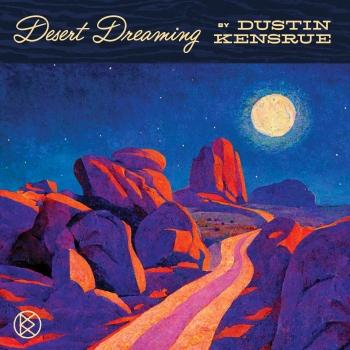Dustin Kensrue
Biographie Dustin Kensrue
Dustin Kensrue
was still a teenager when he formed Thrice, the dynamic and multifaceted rock band who have been bending and blending genres for the past quarter century. Before the group’s touring schedule took him around the world, he spent his childhood in Southern California, regularly heading into the desert to visit his paternal grandparents in Palm Springs. While there, he would wander for hours through the rocky hills and sandy washes near their home, and the landscape, colors, and stories of that sun-baked wilderness left a lasting impression.
Decades later, Kensrue summons the spirit of the American southwest with his third original studio solo album, the evocative and eclectic Desert Dreaming. It’s a transportive album that blurs the lines between genre and geography, balancing the influence of old-school country western icons like Marty Robbins and Gene Autry with the sharp songwriting of a modern musician who’s spent 25 years on the road, onstage, and in the writing room. Kensrue approaches these songs like a western novelist, filling them with details of the desert—the sound of coyotes howling in the distance, the smell of sage and lilac in the dry wind, the lure of hidden treasure in the hills—and punctuating the recordings with pedal steel guitar, train beats, and the strongest melodies of his career.
“The setting really is the main character of the record,” says Kensrue. “I grew up in the southwest, and over time, you can get so used to a certain kind of beauty that you stop seeing it. I used to think, ‘It’s just so brown here.’ When I moved back to the southwest after living in the Pacific Northwest for a little bit, I gained a totally new appreciation for the landscape. I fell in love with the desert all over again.”
That sense of rediscovery—of finally seeing something that’s been right in front of you all along—runs throughout the self-produced record. On “Lift Your Eyes,” Kensrue’s booming voice floats above a backdrop of tremolo guitar and shuffling percussion like it’s echoing off the canyon walls, adding gravitas to the song’s message. “It’s about trying to genuinely experience the expansive world that’s laid out in front you, and not getting trapped in some shrunken and abstracted version of it,” he says. “We all have ways of imposing our own narratives and structures onto the world. These can be useful, but they aren’t the thing itself. Sometimes we need to step back and really look at what’s there instead of what we expect to see, both literally and metaphorically.”
A similar theme anchors songs like “Treasure in the West” — a campfire tune about someone too blinded by goldlust to see the riches all around them — and “Heart of Sedona.” In the latter song, a man leaves the Verde Valley to join the seminary, only to lose his way, tangled up in “councils and creeds.” His wandering eventually leads him home again, now an old man, and the final verse finds him again back amongst the sandstone buttes of Sedona, preaching a different kind of gospel. “That holy cross is truly something,” he sings, “but Cathedral Rock’s the only church I need.”
“So many of these songs are tied into the way I personally re-experienced the desert,” explains Kensrue, who wrote Desert Dreaming on his acoustic guitar and recorded most of the album at home, joined by collaborators like upright bassist Seth Richardson, pedal steel guitarist Ave Levy, and drummer James McAlister. “I no longer look outside and say, ‘There’s that brown space.’ I can actually see it now. There are layers and layers of beauty everywhere you look. Desert Dreaming is both a love letter to the southwest and a personal travel journal of my own experiences in learning to open my eyes to the world in front of me.”
As a SoCal teenager who cut his teeth on punk-rock, Kensrue grew up avoiding the country music that would eventually inspire Desert Dreaming. Johnny Cash became his gateway drug, followed by classic crooners like Patsy Cline, cult heroes like Townes Van Zandt, and alt-country pioneers like Whiskeytown, Drive-By Truckers, and Wilco. “That music was a portal into a different time and a different way of telling stories,” he remembers. “It became something that pulled on me, and it became inevitable that I’d write a record like this. I think there’s something to be said for creating art that you have to make, even if it might disappoint or confuse someone else. There’s a real depth to just doing what you have to do.”
It’s been years since Kensrue made his earliest trips into the Sonoran Desert to visit his grandparents, gaining an appreciation for the southwestern landscape along the way. But this record itself reaches even further back, leaning heavily into the ethos and aesthetics of the country and western music of the 50’s and 60’s. And following another thread into the mid-century he opens Desert Dreaming with “Death Valley Honeymoon,” a song about his mother’s parent’s own honeymoon in the Mojave Desert. It’s a personal moment of an album that mixes biography, history, and fiction, and it’s one of the many songs that make this Desert bloom. Everything that follows—the deep growl of Kensrue’s baritone guitar, the spring reverb that drifts skyward like woodsmoke, the trail-riding twang of songs like “Leaving Tonight For Santa Fe”—shows just how expansive Kensrue’s music can really be.











